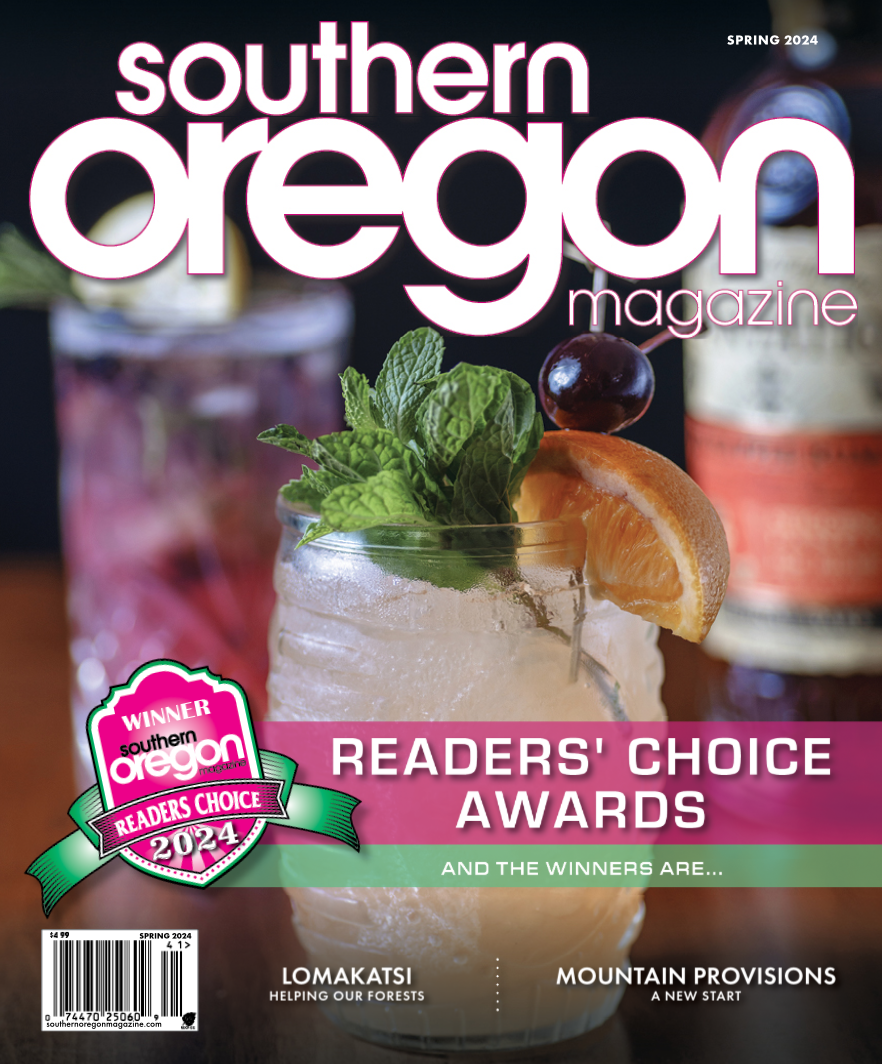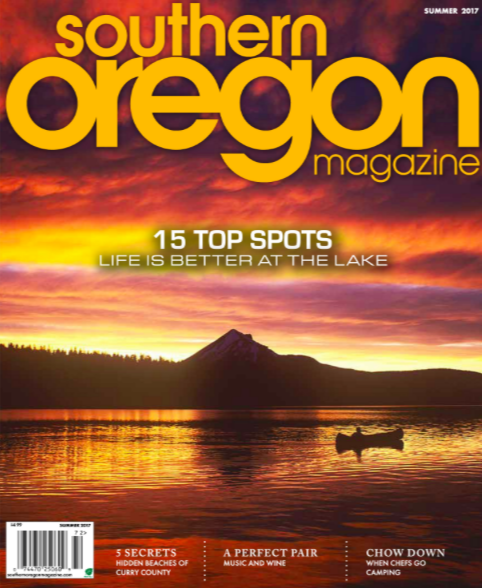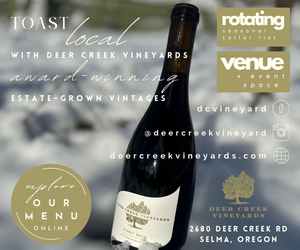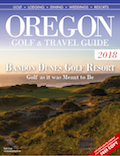

 Spring '24 Issue - Best Of Winners Announced & More
Spring '24 Issue - Best Of Winners Announced & More 
Wednesday, July 26, 2017
To which lake shall we go? Southern Oregon Lakes
Eenie, Meenie, Miney Mo
To which lake shall we go?
Southern Oregon Lakes
Story by Lynn Leissler
“Let’s go to the lake!” In some locales, that would necessitate a long drive and offer limited choices. We in Southern Oregon, however, are blessed with an abundance near and far. The region’s lakes have much to offer, whether you fish, swim, boat, or just enjoy being near water. A simple Google search yielded over sixty lakes from the coast to the Klamath Falls area, from the Roseburg area to the California border. As my friend Carroll quipped, “Eenie, meenie, miney mo––to which lake shall we go?”
A couple of years ago, The Ranger offered thoughts and safety tips about camping. He’s back this summer, enthusiastic about Southern Oregon lakes and safety, reminding us, “Nature is dynamic, not static.” He will help guide us through a sampling of lakes in our region, some an hour or two away, others requiring a weekend for travel time and enjoyment once you arrive.
Nearby mile-high Hyatt Lake offers fishing, a campground, a picnic pavilion and fireplace, and abundant wildlife viewing. Rental boats are available, including eight-person pontoon boats. The resort has a restaurant for those who would rather someone else do the cooking. Hyatt Lake is located in the Cascade-Siskiyou National Monument, the first U.S. National monument set aside solely for the preservation of biodiversity, and features plant life found only there and in parts of Alaska.
Howard Prairie Lake has tent and RV sites and showers. Visitors can also rent lodging and eat at the restaurant. For decades, people drove to Howard Prairie for soft serve ice cream, and the tradition continues today. An earthen jetty in the large marina allows access for those with limited mobility. You’ll see sailboats at Howard Prairie, and their owners formed a yacht club, bringing to mind blue blazers, brass buttons, and white flannel trousers; but this is dressed-down Oregon. The club sponsors sailing competitions and regattas. Boat fuel is available for purchase. You might enjoy the nearby butterfly habitat, as well as mountain views and sunsets. Historically, the region around both Hyatt and Howard Prairie Lakes was summer range for cattle. A few buildings from that era remain.
The Ranger describes Fish Lake as having a calm, sedate atmosphere, a place for “old geezers like me”—which he isn’t. There’s a 10-mph boat speed limit, and you can rent boats, including a party barge. It’s a fisherman’s paradise, the only one in Southern Oregon with tiger trout (catch and release). The two big campgrounds have flush toilets, an important amenity to some. The trails are doable for all ages and abilities, and High Lakes Trail connects Fish Lake with Lake of the Woods. One end of the trail accommodates cyclists, and doesn’t require a high-end bike to navigate the terrain. The southern end of the Sky Lakes Wilderness is accessible from this area. Come winter, Fish Lake draws ice fisher folks, although just now we’re into shorts and sandals, not parkas.
Lake of the Woods is another lake less than two hours away for most Rogue Valley residents. High speeds are allowed and a few boaters crank up the music, causing some to call it a party lake. Still, many people own family cabins their parents purchased and they, now retired, enjoy a low-key summer experience, pleased to watch their grand and great-grandchildren play as they once did. Over 200 cabins surround the lake; the first one built in 1870 by Captain O.C. Applegate, the man who named the lake. The oldest still standing was built in 1912. Lake of the Woods has a more steady lake level than others, and a boat ramp, campgrounds, a restaurant and store. The local YMCA holds a weeklong summer camp there. Here, too, there’s ice fishing in winter. My granddaughter Renee and I spent a Saturday at the lake and saw boats, canoes, paddle surfers, and empty pedal boats. We enjoyed great weather, kids’ fishing derby, biking, and canoeing. At sunset she sat dockside and received a private art lesson from a friend.
At Fourmile Lake, another close-by lake, folks can experience a more basic and primitive lake/camping experience with no extra amenities. You can drive in on a light duty gravel road, sedans okay. The Fourmile area provides access to the east side of Sky Lakes Wilderness.
The Sky Lakes Wilderness has several basins with a number of lakes and trails, a more natural area. Many trails are limited to hikers or pack animals, and the region features panoramic views and close proximity to the Pacific Crest Trail. At the start of the season beware of late snows and tons of bugs. Research before heading out to check the weather, and which trails are open and their condition.
As you head to many of these lakes, keep an eye out for mounds of lava rock, testament to the region’s geological history. Check individual websites for summer activities—fireworks (Lake of the Woods), movies, ranger talks, live entertainment, and more. Rental boats and cabins are available at some lakes. Some allow water sports, others do not. And if you feel winded, it’s not just the breathtaking views. Many of these lakes sit at elevations of over 4-5,000 feet. The brave can swim if they choose. Each lake has its own fishing restrictions beyond state regulations, and some offer fish cleaning stations. Unique plants dot the landscape, and mushroom hunters can go on a search at some locations.
Close to Ashland, Emigrant Lake now has decent water levels following the drought. The lake offers boating and fishing opportunities, camping facilities, and a pavilion available for events. Its best feature, according to some, is the giant waterslide. Check the website to make sure the slide is operational the day you want to go.
Willow Lake, set at the base of Mt. McLoughlin, has a small number of rental cabins and yurts, a picnic area, a boat ramp, and a swim beach. It’s a good place to reel in catfish, bass, bluegill, and trout. If fishing isn’t your thing, Willow Lake is a great for hiking and swimming, or just relaxing.
Upper Klamath Lake (sometimes called Klamath Lake) is the largest natural lake in Oregon and the largest freshwater body west of the Rockies, thirty miles long and up to eight miles wide. One of its unique features is a canoe trail, 9.5 miles through a dramatic mix of marsh, open lake, and forest. From shore or on the water, visitors can view wildlife or reel in almost a dozen varieties of fish, with a one-fish limit on larger fish. This lake also has sailing and a local yacht club.
Lost Creek Lake is a reservoir on the Rogue River with a marina, boat ramps, and fish cleaning stations. Nature trails and picnic areas are there for a day’s outing, with camping facilities also available. The visitors’ center features nature displays and information. Part of your outing might include a visit to a nearby fish hatchery, always an interesting stop for kids. Rafters can launch at McGregor Park for a float down the Rogue River, and power boaters have a lot of water surface to move on.
We’re lucky to have a national park in our backyard, and a splendid one at that. The unbelievably blue lake is between the seventh and ninth deepest in the world and filled exclusively from snow melt. Crater Lake National Park attracts around a half-million visitors yearly. Some folks come to view the lake and take the rim drive, others to hike or bike. For the intrepid, a 1.1 mile hike to the lake is the ticket—easy going down, notably strenuous going back up, due to the 11% grade. I thought I’d die, but my older brother just walked right up. The Pacific Crest Trail passes through the park. Fishing is allowed, but there are tight restrictions, so check it out first. The park has picnic tables, restaurants and shops, and the historic lodge is worth a peek or a stay.
Less than an hour west out of Grants Pass, Selmac Lake offers boating, fishing, swimming, and camping (including RV). There’s a boathouse, a general store, and hiking trails. Horses are allowed on designated trails.
Diamond Lake, north of Crater Lake, has incredible views of Mt. Thielsen, a peak also known as the lightning rod of the Cascades. Boaters have a choice of five ramps and are limited to 10-mph. Four campgrounds offer numerous sites and include picnic tables, restrooms, showers, garbage bins, and some have RV hookups. The South Shore Picnic Area has a playground, volleyball court, horseshoe pits, a swimming beach, and picnic accommodations. There’s a motel and several styles of cabins, and a restaurant if you didn’t pack your own food. You might consider horseback riding while you’re there. If you like the area, you might go back in the winter for ice fishing and snowmobiling.
Squaw Lakes (Big and Little) out of Ruch are accessible by vehicle, but you have to park then haul your camping equipment. Only paddleboats are allowed on the lake, making it a great place to canoe or raft and enjoy the wildlife.
About 10 miles up the road from Squaw Lakes is Applegate Lake, a long lake with several arms. The Applegate Recreation Area has four camp parks nearby, two day-use swimming areas, and dry RV parking available. Hikers can take trails that follow the 17.5-mile shoreline. The 10-mph boat speed makes it a great place to slow down and enjoy the scenery. On an outing with friends, Renee and I went almost-kayaking. Not a new sport, just a great activity cut short by thunder and lightning and rain. The campsites and store are operated seasonally.
The Ranger feels people see a forest ranger as a person somewhere between an adult Eagle Scout and a Canadian Mountie—a rugged, independent individual who advocates for and protects both nature and man. “My emphasis is on public safety.” He underlines the need to plan and the wherewithal to survive if disaster, major or minor, strikes. Carry essential survival equipment: waterproof matches in a container, candle or other fire starter material, space blanket, garbage bag or waterproof poncho, knife, whistle, signal mirror, extra clothing/food/water, detailed map of the area, compass, flashlight, first aid kit, metal cup, 30’ nylon shroud line. Hopefully it all stays stowed. Leave a detailed trip plan with a responsible person, including names and physical descriptions of your fellow travelers, and a description and license plate numbers of all vehicles. Go slow on forest roads for safety and out of respect for others, the environment, and forest life.
“Be nice to each other,” the Ranger urges. Sounds basic, but tempers can flare. He invites people to ask the rangers questions about how to do things, the history of an area, and conditions. “We’re public servants first and foremost.”
Fire safety is crucial. As Smokey Bear famously advises: “Remember, only YOU can prevent forest fires.” Light campfires only if allowed or safe, put them out, and be prepared if one gets out of control.
Water safety is also crucial. Know how to swim, teach your kids how, always use personal floatation devices, and remember that mountain lake water is cold. Check on lake conditions and keep an eye on weather—waves and lightning can change a fun outing into a tragedy in moments. Know what to do in such conditions. (Check the National Weather Service site.) The Ranger cautions against excessive drinking and boating, reminding folks that the combination can be as deadly on the water as it is on the highway. Boaters are reminded to never launch a dirty boat, and to clean, scrub, drain and dry their boats afterward to help stop the spread of highly destructive water life, plants, diseases, and viruses.
If you want to go farther afield than what we’ve covered here, dig out a map and consider heading west to the coast or east to the Nevada border. Either direction, you’ll find more lakes. Wherever you choose to enjoy the water, be prepared. Check websites—we’ve only skimmed the surface—to determine what each lake has to offer and what restrictions apply. Then grab your safety kit, sunscreen, bug spray, a hat, and head out. The lakes await you. Smiling, the Ranger would wave you off with these words: “Be safe and have fun.”
Oregon Department of Fish and Wildlife
National Forest Service
National Weather Service
Bureau of Land Management
Events & Promotions
Apr
19
Apr
20
Apr
21
Jacksonville
David Pinsky & Phil Newton play Rellik winery
Dave Pinsky & Phil Newton play Rellik Winery
Apr
26
Apr
27











